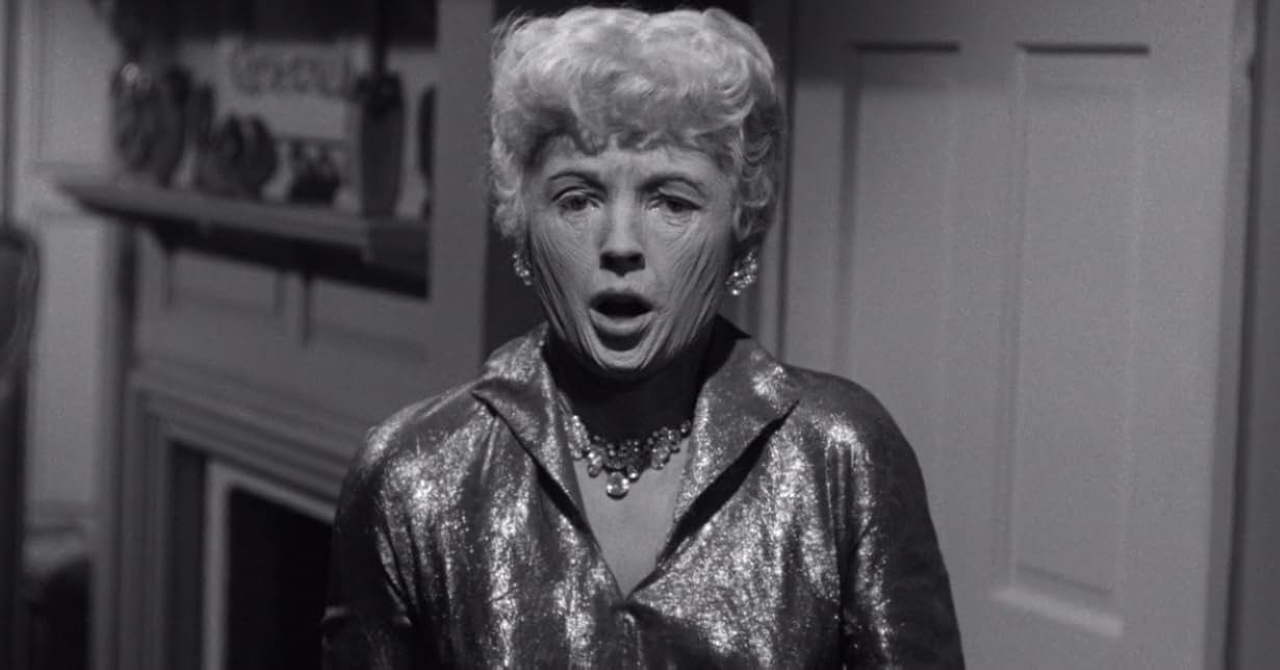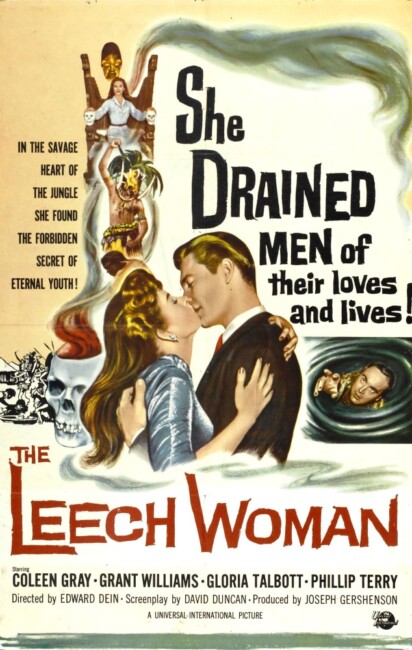Crew
Director – Edward Dein, Screenplay – David Duncan, Story – Ben Pivar & Francis Rosenwald, Producer – Joseph Gershenson, Photography (b&w) – Ellis W. Carter, Music – Irving Gertz, Makeup – Bud Westmore, Art Direction – Robert Clatworthy & Alexander Golitzen. Production Company – Universal-International.
Cast
Coleen Gray (June Talbot), Grant Williams (Neil Foster), Phillip Terry (Dr Paul Talbot), Gloria Talbott (Sally Howard), John Van Dreelen (Bertram Garvay), Estelle Hemsley (Old Malla), Kim Hamilton (Young Malla), Arthur Batanides (Jerry Landau)
Plot
Scientist Paul Talbot is engaged in researching aging. He and his wife June have a bitter relationship, she having slid into alcoholism because he regards her as over the hill and no longer desires her. He then receives a visit from Malla, one of the Nandos African tribe, who claims to be 150 years old thanks to a secret rejuvenation serum. Paul persuades June to come with him to Africa in search of the Nandos’ secrets. However, once they arrive, they are captured and sentenced to death. Before they are to be executed, Malla demonstrates the rejuvenation process, which requires the killing of a man for his pituitary gland and that it then be eaten along with a powder. Malla emerges from this as a young woman. Paul pushes June to try out the process. She agrees – but insists that Paul be the man killed. After being rejuvenated, June makes an escape, stealing the powder. She soon finds that the process wears off, causing her to become an old woman and that it requires the regular replenishment of glands. Posing as her younger niece, she seduces her lawyer Neil Foster away from his fiancee. However, the process constantly wearing off means that she needs to kill other men to retain her youth.
Universal Studios had their great period of horror movies during the 1930s and 40s with their Frankenstein, Dracula, Mummy and Invisible Man films. That dried up by the 1950s when genre cinema swung towards making science-fiction films. The last successful gasp was The Creature from the Black Lagoon (1954). Amid this, The Leech Woman was an odd straggler, although it was a B-budget film, only made as a supporting feature to go on a double-bill with the US release of Hammer’s The Brides of Dracula (1960).
I know nothing about David Duncan’s personal life or views. He turned out some screenplays for some fairly solid genre films during this period (see below). It is however fun to speculate as The Leech Woman reads as something highly personal, the work of someone caught in a not terribly happy marriage. Certainly, themes of disharmony in marriage and wives who had lapsed into alcoholism or were desperate to retain their looks turned up in several other genre films of this period – see also Attack of the 50 Foot Woman (1958) and The Wasp Woman (1959).
The opening scenes contain some rather funny dialogue in the embittered bickering between scientist Phillip Terry and wife Coleen Gray, the upshot of which he seems to be that she has lapsed into alcoholism and become bitter because he no longer desires her due to her having gotten old – he even comes out with lines like “old women give me the creeps.” There is a good deal of what today reads as rather sexist talk about how Coleen Gray has lost her worth because she has lost her beauty. Her arc throughout the film goes from a woman who has lapsed into alcohol because she has become middle-aged and her husband no longer desires her, to she gleefully taking revenge by nominating him as the party whose pineal has to be selected for the rejuvenation process to then posing as her younger niece, seducing lawyer Grant Williams away from his fiancee and predatorily killing men for their pineal glands to keep herself young. To say that someone in the conception of the film might have had a few unresolved issues with women could well be an understatement.

The Leech Woman works okay as a horror film. There is a trip to Africa that consists of some obvious backlot sets and stock footage of animals, which was fairly standard for the era. The makeup job that turns Coleen Gray into a leathery old woman is passably convincing. The actual transformation effect is a simple stage magician’s sleight of hand where the old woman is covered by a cloud of smoke, which clears to reveal the younger one sitting in her place. It should be noted that when Coleen Gray undertakes the rejuvenation process and emerges from the smoke cloud, her bedraggled middle-age self has magically undergone the application of makeup.
Director Edward Dein had begun in the industry as a screenwriter where he had written a number of Westerns. He had also written several horror films, including additional dialogue for the Val Lewton film The Leopard Man (1943) and the screenplays for Calling Dr Death (1943), Jungle Woman (1944), The Soul of a Monster (1944) and The Cat Creeps (1946). He made seven films as director, including two co-directed in Spain. His only other horror outing as director was the vampire Western Curse of the Undead (1959).
David Duncan was also a regular genre writer with the screenplays for the English-language version of Rodan the Flying Monster (1956) and the original screenplays for The Black Scorpion (1957), The Monster That Challenged the World (1957), Monster on the Campus (1958), The Thing That Couldn’t Die (1958), The Time Machine (1960) and Fantastic Voyage (1966).


